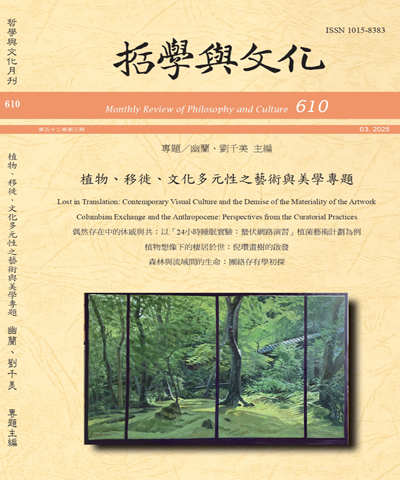
哲學與文化/Universitas: Monthly Review of Philosophy and Culture
哲學與文化月刊雜誌社,正常發行
選擇卷期
- 期刊
歐美漢學界對中國思想史方面的研究興趣,首推老子哲學,次及儒釋道三教異同問題。由於玄學概以「易」「老」「莊」三玄之學為主,而魏晉南北朝的變動期文化又較為多彩多姿,故三教異同之爭所觸及的「宗教」「哲學」「政治」三者間的錯綜性課題,便相當引起西方漢學界的探討興趣。本文乃就歐美漢學界對「魏晉玄學」的論述,特以其對王弼、嵇康、郭象、僧肇等人的研究成果為主,略選代表作數篇,稍試評介,以觀其要。
- 期刊
眾所周知,「言不盡意」乃魏晉玄學理論建構的方法論。其源頭根據則在於先秦《老子》的「道可道,非常道」,《莊子》的言、意、超言意的三層區分,以及《周易.繫辭傳》的「書不盡言,言不盡意」等觀念。 魏晉言意理論雖然多端,基本上仍以「言不盡意」為主軸,其中又以王弼「得意忘象」最具代表性。他以「名號」符應客觀事物,「稱謂」指涉主觀意求,以及不可言說的「自然之道」三個層次建構言意理論,展開玄學的論述。歐陽建的〈言盡意論〉雖是持客觀主義的立場,然其論述之內容和王弼之「名號」頗相一致。至於郭象的「寄言出意」,則未出「得意忘象」的範圍。 「言不盡意」的方法論,其作用在敞開經典的詮釋,達到會通儒道的目的。
- 期刊
Sun Sheng (307-378) was an important historian and thinker of the mid-Eastern Chin dynasty. The main trend of Eastern-Chin hsiianhsiieh, after Kuo Hsiang's interpretation of the Chuang Tzu, was a syncretism of Confucianism and Taoism. Most thinkers of the time dwelled in the real world, paying particular attention to the relation between ”affection” and ”rite.” With perspectives from the commentarial tradition and a reflection on the so-called liberating atmosphere of this period, looking at it in the context of the overall development of hsiianhsiieh, we can better comprehend the meaning of this syncretism. . This paper studies Sun Sheng's thought and his essays, ”Lao-tzu iwen fan-hsiln” and ”Lao-tan fei ta-hsien lun.” The author offers discussions of why Sun Sheng was so ardently against Lao Tzu by comparing Sun Sheng and Wang Pi's works. Wang Pi contributed the concept of ”original non-being” (pen-wu) to Taoism. Accordingly, all beings originated from non-being, hence non-being was an innate nature of all beings. The substance (non-being, ti) and the appearance (being, yung) are the two aspects of Tao, partaking of ”mystery” (hsilan). Indeed, Tao is the mystery of all mysteries. In Sun's interpretation, the concept of Tao expressed in the Lao Tzu is contradictory, since Lao Tzu preferred the significance of non-being to every being. This paper argues that Sun Sheng's comprehension of Lao Tzu's thought is limited, and that Sun seemed to have no acquaintance with Wang Pi's commentary on the Lao Tzu. In the conclusion, the author evaluates Sun Sheng's thought expressed in the essays in the context of the history of hsiian-hsileh in the Wei-Chin period.
- 期刊
玄遠之學係探究一切存在物深遠的根源之理,亦即務本體之理的玄學。魏晉玄學問題焦點移置於「無(本性)與」「有(現象)」,亦即本真性的「存有(being)」與現象中的具體「存在(existence)」之分別涵義及相互關係來進行哲學探索。扼要言之,被稱為「新道家」的魏晉玄學為了解決儒家外王機制的名教與道家歸真反樸(素樸之性)的自然所產生的相互矛盾和危機,藉在這一脈絡下來理解自我,定位自我與他人和天地萬物間的相互關係,安頓個體與群體的生命。魏晉三大思潮:才性名理學、玄理名理學和東晉玄佛交涉的格義佛學。就方法的革新而言,魏晉玄學擺脫了兩漢經學的荒誕、瑣碎和腐化,朝向名家辨名析理的邏輯思辨法、《莊子》及《易經》的寄言出意法、藉經典而通理的自由詮釋法,意象思考法以及在生活世界中與情境互動的體驗法。我們擬對魏晉玄學的要義進行概括性的瞭解,則可透過哲學中的三大主題:存有論、認識論及價值論,予以扼要的紹述,藉此,或可引領讀者對魏晉玄學得到初步的導覽之效。
- 期刊
Though revolving around the differentiations between ”essential and non-essential” as well as ”being and nothingness,” Neo- Taoism in the Wei and Jin Periods contains a lot of discourses on the creation and transformation of the material world from the perspective of metamorphosis. Those discourses are generally divided into three different types of theories: He Yian, Wang Bi, Han Kang-bo, Zhang Zhan and Lie-zi maintain that ”Qi transforming into Nature from nothing”; Ruan Ji, Ji Kang, and Guo Xiang believe ”Qi is nature cultivating everything,” assuming that Qi is nature without any ultimate essence; besides, Yang Quan proposes that Qi is the essence of nature and that everything in the universe is made from Qi, by which he also tries to interpret the change of seasons. All these various theories are all based on the doctrine that Qi transforms into nature by doing nothing, which is characteristic of the theories of Qi in the Wei and Jin Periods.

